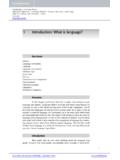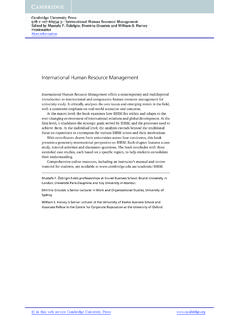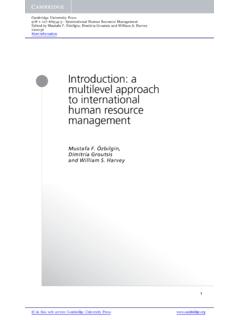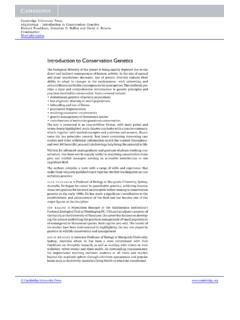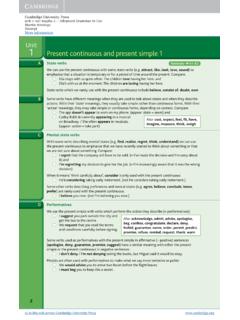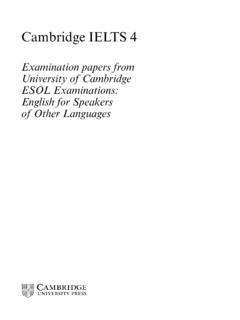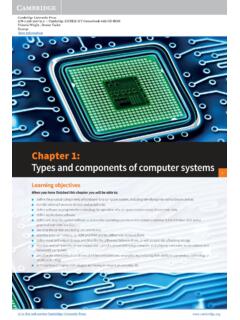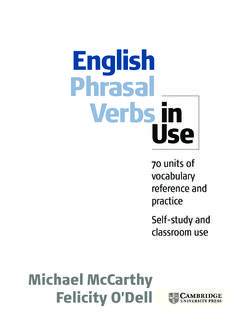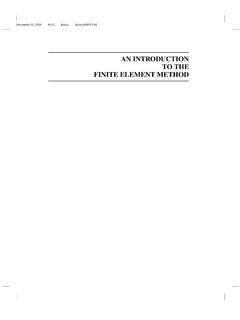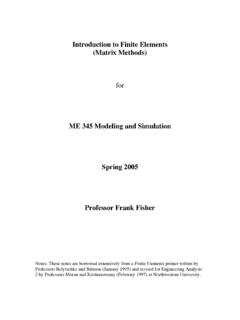Transcription of INTRODUCTION TO FINITE ELEMENT VIBRATION ANALYSIS, …
1 Cambridge University Press 978-0-521-19160-9 - INTRODUCTION to FINITE ELEMENT VIBRATION analysis , second edition Maurice Petyt Frontmatter More information INTRODUCTION TO FINITE ELEMENT VIBRATION . analysis , second edition . There are many books on nite ELEMENT methods but few give more than a brief description of their application to structural VIBRATION anal- ysis. This book presents an INTRODUCTION to the mathematical basis of nite ELEMENT analysis as applied to vibrating systems. FINITE ele- ment analysis is a technique that is very important in modelling the response of structures to dynamic loads. Although this book assumes no previous knowledge of nite ELEMENT methods, those who do have knowledge will still nd the book to be useful. It can be utilised by aeronautical, civil, mechanical and structural engineers as well as naval architects. This second edition includes information on the many developments that have taken place over the last 20 years.
2 Existing chapters have been expanded, where necessary, and three new chap- ters have been included that discuss the VIBRATION of shells and multi- layered elements and provide an INTRODUCTION to the hierarchical nite ELEMENT method. Maurice Petyt is an Emeritus Professor of Structural Dynamics, Insti- tute of Sound and VIBRATION Research, University of Southampton. He has also held appointments as a Research Professor at George Washington University and Visiting Professor at the University d'Aix- Marseille II, France, and the National University of Singapore. He is a Charted Mathematician, a Fellow of the Institute of Mathematics and Its Applications, a Fellow of the International Institute of Acoustics and VIBRATION , and a Fellow of the Institute of Acoustics. Formerly European Editor and Editor-in-Chief, he is now Editor Emeritus of the Journal of Sound and VIBRATION .
3 In this web service Cambridge University Press Cambridge University Press 978-0-521-19160-9 - INTRODUCTION to FINITE ELEMENT VIBRATION analysis , second edition Maurice Petyt Frontmatter More information INTRODUCTION to FINITE ELEMENT VIBRATION analysis second edition Maurice Petyt University of Southampton in this web service Cambridge University Press Cambridge University Press 978-0-521-19160-9 - INTRODUCTION to FINITE ELEMENT VIBRATION analysis , second edition Maurice Petyt Frontmatter More information cambridge university press Cambridge, New York, Melbourne, Madrid, Cape Town, Singapore, Paulo, Delhi, Dubai, Tokyo, Mexico City Sao Cambridge University Press 32 Avenue of the Americas, New York, NY 10013-2473, USA. Information on this title: . C Maurice Petyt 1990, 2010. This publication is in copyright. Subject to statutory exception and to the provisions of relevant collective licensing agreements, no reproduction of any part may take place without the written permission of Cambridge University Press.
4 First edition published 1990. second edition published 2010. Printed in the United States of America A catalog record for this publication is available from the British Library. Library of Congress Cataloging in Publication data Petyt, M. INTRODUCTION to nite ELEMENT VIBRATION analysis / Maurice Petyt. 2nd ed. p. cm. Includes bibliographical references and index. ISBN 978-0-521-19160-9. 1. VIBRATION . 2. FINITE ELEMENT method. I. Title. 2010. 76 dc22 2010029494. ISBN 978-0-521-19160-9 Hardback Cambridge University Press has no responsibility for the persistence or accuracy of URLs for external or third-party Internet Web sites referred to in this publication and does not guarantee that any content on such Web sites is, or will remain, accurate or appropriate. in this web service Cambridge University Press Cambridge University Press 978-0-521-19160-9 - INTRODUCTION to FINITE ELEMENT VIBRATION analysis , second edition Maurice Petyt Frontmatter More information Contents Preface page xi Notation xv 1 Formulation of the Equations of Motion.
5 1. Dynamic Equilibrium 1. Principle of Virtual Displacements 3. Hamilton's Principle 4. Lagrange's Equations 8. Equations of Motion for a System with Constraints 12. Problems 15. 2 ELEMENT Energy Functions .. 19. Axial ELEMENT 20. Torque ELEMENT 21. Beam Bending ELEMENT 23. Deep Beam Bending ELEMENT 25. Membrane ELEMENT 26. Thin Plate Bending ELEMENT 28. Thick Plate Bending ELEMENT 30. Three-Dimensional Solid 31. Axisymmetric Solid 33. The Dissipation Function 35. Equations of Motion and Boundary Conditions 36. Problems 40. 3 INTRODUCTION to the FINITE ELEMENT Displacement Method .. 45. Rayleigh Ritz Method 45. FINITE ELEMENT Displacement Method 53. Axial VIBRATION of Rods 56. Torsional VIBRATION of Shafts 70. Bending VIBRATION of Beams 72. VIBRATION of Plane Frameworks 77. v in this web service Cambridge University Press Cambridge University Press 978-0-521-19160-9 - INTRODUCTION to FINITE ELEMENT VIBRATION analysis , second edition Maurice Petyt Frontmatter More information vi Contents VIBRATION of Three-Dimensional Frameworks 84.
6 Techniques for Increasing the Accuracy of elements 92. Shear Deformation and Rotary Inertia Effects 95. Numerical Integration 101. Other Considerations for Beams 112. Problems 115. 4 In-plane VIBRATION of Plates .. 119. Linear Triangular ELEMENT 120. Linear Rectangular ELEMENT 127. Linear Quadrilateral ELEMENT 132. Area Coordinates for Triangles 137. Linear Triangle in Area Coordinates 138. Increasing the Accuracy of elements 139. Problems 144. 5 VIBRATION of Solids .. 148. Axisymmetric Solids 148. Applied Loading 149. Displacements 152. Reduced Energy Expressions 152. Linear Triangular ELEMENT 153. Core elements 160. Arbitrary Shaped Solids 163. Rectangular Hexahedron 165. Isoparametric Hexahedron 170. Right Pentahedron 174. Volume Coordinates for Tetrahedra 178. Tetrahedron ELEMENT 180. Increasing the Accuracy of elements 182. Problems 190. 6 Flexural VIBRATION of Plates.
7 192. Thin Rectangular ELEMENT (non-conforming) 193. Thin Rectangular ELEMENT (conforming) 204. Thick Rectangular ELEMENT 209. Thin Triangular ELEMENT (non-conforming) 215. Thin Triangular ELEMENT (conforming) 222. Cartesian Coordinates 222. Area Coordinates 228. Thick Triangular ELEMENT 234. Other Plate Bending elements 237. Problems 245. 7 VIBRATION of Stiffened Plates and Folded Plate Structures .. 248. Stiffened Plates I 248. in this web service Cambridge University Press Cambridge University Press 978-0-521-19160-9 - INTRODUCTION to FINITE ELEMENT VIBRATION analysis , second edition Maurice Petyt Frontmatter More information Contents vii Stiffened Plates II 252. Folded Plates I 257. Folded Plates II 259. Folded Plates III 262. Problems 265. 8 VIBRATION of Shells .. 266. Thin Shell elements 266. Thick Shell elements 268. Middle Surface Shell ELEMENT 269.
8 Thick Axisymmetric Shell elements 277. Middle Surface Axisymmetric Shell ELEMENT 277. Problems 283. 9 VIBRATION of Laminated Plates and Shells .. 284. Laminated Plate elements 285. Classical Laminated Plate Theory 285. First-Order Shear Deformation Plate Theory 288. Third-Order Shear Deformation Plate Theory 290. Laminated Shell elements 295. Sandwich Plate and Shell elements 295. 10 Hierarchical FINITE ELEMENT Method .. 297. Polynomial Functions 297. Axial VIBRATION of Rods 298. Bending VIBRATION of Beams 300. Flexural VIBRATION of Plates 303. VIBRATION of Shells 306. Trigonometric Functions 307. Axial VIBRATION of Rods 307. Bending VIBRATION of Beams 309. In-plane VIBRATION of Plates 310. Flexural VIBRATION of Plates 311. VIBRATION of Shells 314. 11 analysis of Free VIBRATION .. 316. Some Preliminaries 316. Orthogonality of Eigenvectors 322. Transformation to Standard Form 322.
9 Sturm Sequences 326. Orthogonal Transformation of a Matrix 334. Eigenproblem Solution Methods 334. Reducing the Number of Degrees of Freedom 336. Making Use of Symmetry 336. Rotationally Periodic Structures 338. in this web service Cambridge University Press Cambridge University Press 978-0-521-19160-9 - INTRODUCTION to FINITE ELEMENT VIBRATION analysis , second edition Maurice Petyt Frontmatter More information viii Contents Elimination of Unwanted Degrees of Freedom 343. Component Mode Synthesis 349. Fixed Interface Method 349. Free Interface Method 352. Problems 355. 12 Forced Response I .. 357. Modal analysis 357. Representation of Damping 358. Structural Damping 358. Viscous Damping 359. Harmonic Response 361. Modal analysis 361. Direct analysis 370. Response to Periodic Excitation 377. Transient Response 381. Modal analysis 381. Central Difference Method 384.
10 The Houbolt Method 389. The Newmark Method 394. The Wilson Method 400. Direct analysis 402. Central Difference Method 403. The Houbolt Method 408. The Newmark Method 409. The Wilson Method 409. Selecting a Time Step 410. Additional Methods 411. Problems 411. 13 Forced Response II .. 413. Response to Random Excitation 413. Representation of the Excitation 413. Response of a Single Degree of Freedom System 423. Direct Response of a Multi-Degree of Freedom System 426. Modal Response of a Multi-Degree of Freedom System 430. Truncation of the Modal Solution 431. Mode Acceleration Method 435. Residual Flexibility 437. Ritz Vector analysis 438. Response to Imposed Displacements 440. Direct Response 440. Modal Response 442. Reducing the Number of Degrees of Freedom 443. Making Use of Symmetry 443. Rotationally Periodic Structures 444. in this web service Cambridge University Press Cambridge University Press 978-0-521-19160-9 - INTRODUCTION to FINITE ELEMENT VIBRATION analysis , second edition Maurice Petyt Frontmatter More information Contents ix Elimination of Unwanted Degrees of Freedom 446.
